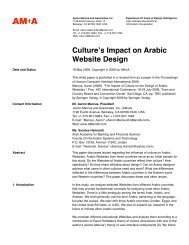Globalization of User-Interface Design for the Web - Aaron Marcus ...
Globalization of User-Interface Design for the Web - Aaron Marcus ...
Globalization of User-Interface Design for the Web - Aaron Marcus ...
You also want an ePaper? Increase the reach of your titles
YUMPU automatically turns print PDFs into web optimized ePapers that Google loves.
Consider differences <strong>of</strong> hyphenation, insertion point location,<br />
and emphasis, i.e., use <strong>of</strong> bold, italic, quotes, double quotes,<br />
brackets, etc.<br />
Use appropriate abbreviations <strong>for</strong> such typical items as<br />
dates, time, and physical measurements. Remember that<br />
different countries have different periods <strong>of</strong> time <strong>for</strong><br />
"weekends" and <strong>the</strong> date on which <strong>the</strong> week begins.<br />
Conclusion<br />
<strong>User</strong>-interface design <strong>for</strong> <strong>the</strong> <strong>Web</strong> requires attention to<br />
globalization issues in <strong>the</strong> user interface development<br />
process. As technology increases <strong>the</strong> number and kinds <strong>of</strong><br />
functions, data, plat<strong>for</strong>ms, and users <strong>of</strong> computer-based<br />
communication media, <strong>the</strong> challenge <strong>of</strong> enabling more<br />
people and more kinds <strong>of</strong> people to use this content and<br />
<strong>the</strong>se tools effectively will depend increasingly upon global<br />
solutions. By recognizing <strong>the</strong> need <strong>for</strong>, and benefit to users<br />
<strong>of</strong> user-interface designs intended <strong>for</strong> international and<br />
intercultural markets, developers will achieve greater<br />
success and increased pr<strong>of</strong>itability through <strong>the</strong> global<br />
distribution and acceptance <strong>of</strong> <strong>the</strong>ir products.<br />
Acknowledgements<br />
Mr. <strong>Marcus</strong> thanks co-authors, his staff at <strong>Aaron</strong> <strong>Marcus</strong> and<br />
Associates, Inc., and Dr. Constantine Stephanidis, Director<br />
<strong>of</strong> <strong>the</strong> Insitute <strong>for</strong> Computer Science, FORTH, Heraklion,<br />
Crete, Greece, editor <strong>of</strong> <strong>User</strong> <strong>Interface</strong>s <strong>for</strong> All, Lawrence<br />
Erlbaum Associates Publishers, New York, 1999 , <strong>for</strong> <strong>the</strong>ir<br />
assistance in preparing this text. This paper is adapted from<br />
<strong>the</strong> chapter "International and Intercultural <strong>User</strong> <strong>Interface</strong>s,"<br />
in that book authored by <strong>Aaron</strong> <strong>Marcus</strong> and cited in <strong>the</strong><br />
Bibliography. The author also acknowledges <strong>the</strong> books by<br />
del Galdo and Nielsen, Fernandes, and Nielsen cited in <strong>the</strong><br />
Bibliography, which provided a basis <strong>for</strong> many points raised<br />
in this text.<br />
Bibliography<br />
AIGA, Symbol Signs, Visual Communication Books,<br />
Hastings House, New York, 1972.<br />
Bliss, C.K., "Semantography," Semantography Publications,<br />
Sidney, Australia. 1965. The article presents a system <strong>for</strong><br />
universal writing, or pasigraphy.






